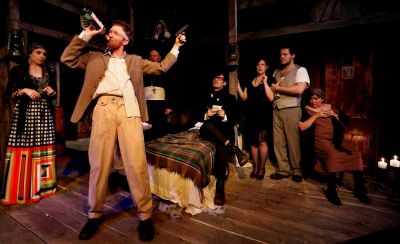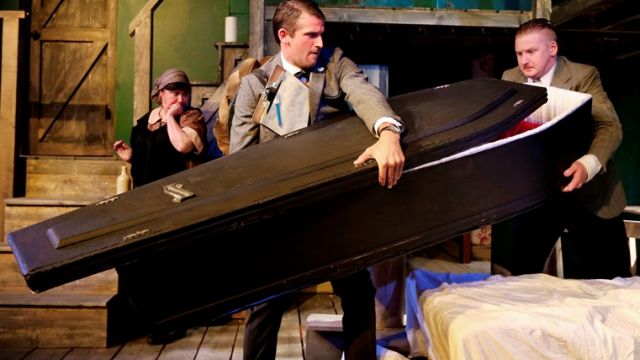Dying For It
Whilst director Peter Talmacs writes of this play as a farce, there is little farcical style in the direction or the acting in this production. In fact, because much of the vocal work is exclamatory and the action postured; because there are recognisable “stock” characters and several tableaus and because the hero survives, it presents much more as a melodrama!
The play is an adaptation of a satire written in 1928 by Russian playwright Nikolai Erdman. It was banned before it was ever performed and Erdman was eventually exiled to Siberia for many years because of his satiric writings. Set in post revolution Russia, it revolves around Semyon Semyonovich Podsekainikov, an out-of-work husband, humiliated by his dependence on his wife and mother-in-law. When he buys a gun and talks of suicide, his neighbour cashes in on his plan by contacting those who might use his suicide to further their political, social and religious causes. They all visit him exhorting him to write a suicide note that will promote their cause or philosophy. Swayed by their praise and rhetoric, he begins to see himself as revered, important, a martyr to Mother Russia.
Long diatribes and posturing exchanges that satirise much about Stalinist Russia and the Russian Orthodox church are the crux of the play and many are delivered well in a style that is suitably satirical and melodramatic. Those scenes in the play mostly work well. And the supporting scenes might also work well if they were also treated as melodrama.
 Because much of the dialogue in this adaptation is heavy and wordy it does not allow for the quick exchanges and fast action that characterize farce. The few scenes that could be treated as farce lack pace and lightness. There is too much heavy stomping around the stage, too little fast repartee, too many laboured lines. Even the opening scene suffers this fate. It is a bedroom scene in the dark where Semyon (Johann Walraven) and his wife Masha (Jodine Muir) argue about a black sausage. It sounds funny, and it could be, but the delivery is too slow and Masha screeches so loudly that some members of the audience actually covered their ears! The appearance of Jeanie Gee as Masha’s mother, Serafima comes as a welcome relief! Gee’s characterisation, comic timing and ability to bite lines effectively pushes the action and raises more than a few laughs throughout the play.
Because much of the dialogue in this adaptation is heavy and wordy it does not allow for the quick exchanges and fast action that characterize farce. The few scenes that could be treated as farce lack pace and lightness. There is too much heavy stomping around the stage, too little fast repartee, too many laboured lines. Even the opening scene suffers this fate. It is a bedroom scene in the dark where Semyon (Johann Walraven) and his wife Masha (Jodine Muir) argue about a black sausage. It sounds funny, and it could be, but the delivery is too slow and Masha screeches so loudly that some members of the audience actually covered their ears! The appearance of Jeanie Gee as Masha’s mother, Serafima comes as a welcome relief! Gee’s characterisation, comic timing and ability to bite lines effectively pushes the action and raises more than a few laughs throughout the play.
Some of the scenes in the second act work well. Walraven’s characterisation of Semyon is much stronger and he delivers his ‘farewell’ monologue in impressive declamatory style. The anticlimax allows for some final flounces and flourishes and some tableaus that involve many of the fourteen performers and use the levels of the set effectively.
In fact, the set and the lighting are the most impressive performers in this production. Tom Bannerman has created a dowdy, scruffy two-storey tenement with peeling paintwork and broken cornices. There are lots of doors and stairways overhung by a precarious-looking balcony. It is an oppressive environment, which Tony Youlden lights with subtle shadows that accentuate the tawdriness of the setting.
Whilst there are some nice individual performances – Christopher Sellers as Aristarkh, Tom Albert as Viktorovich and Joel Spreadborough as Alexander Petrovich Kalabushkin – the production of this weighty adaptation lacks the direction, pace and ensemble punch that is necessary to make it succeed as a farce.
Carol Wimmer
Photographer: Bob Seary.
Subscribe to our E-Newsletter, buy our latest print edition or find a Performing Arts book at Book Nook.

